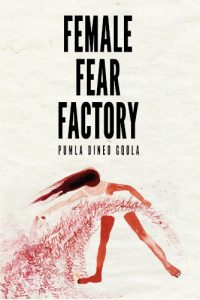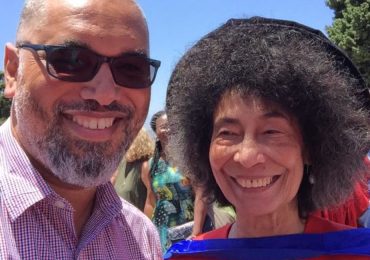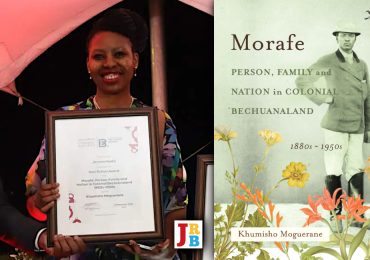The JRB presents an excerpt from Female Fear Factory, the highly anticipated new book from Pumla Dineo Gqola.

Female Fear Factory
Pumla Dineo Gqola
Melinda Ferguson Books, 2021
Foreign Familiars
‘Intimacies generate complex pushes and pulls.’—Antwi et al, 2013: 8
The violent outbreaks of 2008 and 2015 across South African cities and towns mirrored each other: the vulnerable were ‘foreign’, living and working in the margins among those who now hounded, killed and disowned them. Victims were immigrants from African and/or South Asian countries. Helene Strauss’ reminder that a third of the 2008 fatalities were South African citizens is a very important one.
In both 2008 and 2015, violence chose pathways of race, gender, class and nationalist power in ways both obvious and blurred. The obvious ways lay in what was rendered visible in the media idiom and public talk: the race, class and gender of the perpetrators posited against the origins and class of those attacked and/or displaced. On television and in print media, young Black men were shown as the perpetrators, going on rampages through economically marginal zones, although occasional images of women and children displaced were also briefly flighted. The assailants were represented toyi-toying and singing liberation struggle songs as they attacked, killed and displaced those they had previously lived amongst. Obviously, this was about the intersections of nationalism, gender, race and class, as all xenophobia is. The singing of anti-apartheid struggle songs as they killed people was highlighted as a particular irony and a source of much anger in the public discourse.
Public outrage assumed that the perpetrators were either ignorant of the past that had made the new South Africa possible, or just inexplicably monstrous. The violent outbreaks were met with mystification in 2008, and horror in 2015. President Jacob Zuma’s 2015 assurances that such violence would never recur echoed President Thabo Mbeki’s earlier insistence that the violence was mere criminality. Neither approach was particularly helpful; criminality and xenophobia are not mutually exclusive, while assurances of ‘never again’ ring hollow, since solutions can hardly be forthcoming for a poorly understood phenomenon. From divergent quarters, the violators were deemed to be acting in contravention of African norms of ubuntu and the spirit of the Constitution, and as ignorant/ungrateful, given the continent’s previous support for anti-apartheid liberation movements. In other words, the violators were in breach of the unwritten codes that make for proper new South Africanness. In the Filmmakers Against Racism’s (FAR) film, Asikhulume, musician Syd Kitchen is visibly upset as he declares: ‘I am very ashamed to be South African today.’
How was it possible for these young men to be so unaware of the shameful contradictions they were performing? And how dare they sing struggle songs while killing Africans, when our immediate neighbours had paid such a high price to make sure that we had this freedom? Did they not understand that in the early days of their own freedom, ordinary Nigerians had paid a tax to subsidise South African exiled students? These sentiments were everywhere—written on the placards held by the tens of thousands who attended marches against xenophobia, espoused by those who offered media commentary and analysis, and felt by the ones who seethed privately. As they should have. But the attacks had equally vocal supporters. The vocal supporters are not the subject of this chapter, however, and there is much South African writing puzzling over these dimensions of the violence. The victims took on tragic visibility. In 2008, the devastating imagery of the attacks was in the form of Mozambican Ernesto Alfabeto Nhamuave’s body engulfed in flames. Adze Ugah’s film The Burning Man follows Nhamuave’s corpse home for burial, converses with a family in shock and devastation, and probes the contradictory relationship South Africa has always had with Mozambican men’s labour. In 2015, the assailants were once again young Black men from Alexandra township, not very different from those interviewed in Danny Turken’s film Affectionately Known as Alex; the broken body on display belonged to another Mozambican man, Emmanuel Sithole, who was sometimes referred to as Josias by those who knew him alive. His was not a body on fire, but the end result was equally devastating: his skull cracked open.
Danai Mupotsa’s work has taught us that boundaries of identity are policed and marked through rituals of production, even though they use a language of recovery. In these rituals of production ‘coherent insides’ and ‘messy outsides’ are cast as antagonistic. For the violent men in the streets and their supporters on the airwaves, the ‘coherent insides’ consisted of South African citizens, whereas the ‘messy outsides’ were occupied by selectively useful ‘foreign nationals’. Most outraged South Africans, however, constructed the boundaries around (South) African legitimacy, amnesia and being inhospitable. It makes sense that the boundaries themselves were a site of production because, after Stuart Hall, we know that ‘as a process [identity] operates across difference, it entails discursive work, the binding and marking of symbolic boundaries’, so these boundaries are unstable. The production of ‘foreign’ is that of the conditionally undesirable. The production of foreigners is also the creation of vulnerability.
- Pumla Dineo Gqola is the author of What is Slavery to Me?, A Renegade called Simphiwe, the 2016 Alan Paton Award-winning Rape: A South African Nightmare and the Alan Paton Award-longlisted Reflecting Rogue. Female Fear Factory is her latest book. Professor Gqola is currently Research Chair in African Feminist Imagination at NMU.
~~~
Publisher information
‘Pumla Gqola’s mind exhilarates … Here is a literary presence that makes thinking a pleasure.’—Professor Njabulo Ndebele
Female Fear Factory is the much-anticipated follow up to the 2016 Sunday Times Alan Paton Award-winning Rape: A South African Nightmare. Like the book on which it builds, Female Fear Factory fuses both razor-sharp intellectual rigour and extensive research.
The ongoing explosion of sexual violence demands more space for the development of the female fear factory concept as well as its possible antidotes. Where Rape introduced strategies for disrupting rape culture at an individual level, Female Fear Factory offers an even bolder vision for collective action against all cultures of sexual violence.
Gqola, an icon of South African feminism, brilliantly traces the construction and machinations of the female fear factory by exposing its myths, lies and seductions. It is an insightful and sobering account of global patriarchal violence while it simultaneously offers a hopeful vision through the eyes of an unapologetic feminist.





